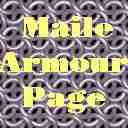Beginning Your Maile Armour
Revised 28 October 1996
Beginning a maile project is almost always the hardest part. Until there are at least four rows of links, no matter how many columns there are, maile lacks the inherent stability of a fabric. When there are only 2 or 3 rows, rings can easily 'flip' and effectively alter your pattern. The ring is still linked properly, but it has come out of place in such a way that it appears to be linked incorrectly. When links flip, your maile can become one hell of a puzzle. There is no good way to describe this phenomenon accurately, but rest assured, you will experience it, and you will then know immediately what I'm talking about.
To combat this, when starting a new piece of maile, I would highly recommend that you complete at least five rows of linked rings before quitting. The corners can still flip and cause problems, but it will make much life easier. If you will not have to move your armour from the place you work on it, the five row rule becomes less important. When you first begin, I would recommend slating 2-3 hours for you beginning effort. That will allow for mistakes, short breaks, and general confusion.
HOW TO MAKE BEGINNING EASIER:
The following method made a huge difference for me when I started out making maile. This method greatly reduces the problems associated with rings flipping. First, choose the number of columns you want to start with (20 is a good number). Then place that number of rings on a straight piece of wire. I use a half way straightened clothes hanger. Now imbricate all of the rings so that they all lean the same way. Start at one end and link an open right through the two endmost rings and use pliers to close the ring. So now there is one ring in the second row linking the first two rings of the first row together. The ring you just added should lean the opposite direction of the rings in row 1, and should enter the two rings in row 1 the same direction. The picture below should help you picture what I am talking about.
![[Image of a piece of maile armour]](maile-ex.gif) Use another open ring to link rings 2 and 3 of row one together, then 3 and 4, 4 and 5, and so on until you reach the end. Now you have two rows of rings. The entire second row should lean the opposite direction from the first.
Use another open ring to link rings 2 and 3 of row one together, then 3 and 4, 4 and 5, and so on until you reach the end. Now you have two rows of rings. The entire second row should lean the opposite direction from the first.
At this point, if you add a link to the first two rings in row 2, you will find that your rows are going to continue to get shorter and shorter as demonstrated by the left side of the picture. To keep this from happening, add a ring to the last ring of row 1 and orient it the way the rest of the rings in row two are oriented. Now link an open ring through that ring and the next ring over and continue across the pattern to make row three. The gray ring shows how to link the solo ring. The right side of the picture shows how the maile will look when you continue to add solo rings. If you do not add the solo rings you will eventually end up with a triangular piece of maile. I plan on using this method to make the base of a hauberk I am working on a bit more interesting. I am going to bring the hauberk down to four points in the four major quadrants.
NOTE: the arrows on the diagram indicate the directions I prefer to proceed in when linking rings. The arrows also indicate the direction of the slant of the rings. For example, a left arrow indicates that I move from right to left when linking rings, and that the rings I am adding to the maile angle down to the left.
Now you have the basics to get yourself started. From your base piece, you can expand your maile in any of the four basic directions. One of the wonderful things about maile armour is its form fitting characteristics. The weave can expand or contract to fit the body (provided that the maile isn't grossly too large or small). For this reason, your maile doesn't have to be perfect as far as size is concerned.
Some things need to be as perfect as possible though. One of them is ring size. Make sure your rings are as equally sized and as perfectly round as possible. Small differences can easily distort your weave, leaving some places that are under more stress than others. These areas are more likely to pull apart on you. Another important thing to make sure you do well, is butting the rings. Make sure that the ends of each ring are butted as closely as possible. This ensures that your equally sized rings actually have the same diameter, and it makes your maile stronger. The best way to learn how to make maile is to practice (and struggle) with it.
SO GO TO IT!!!
![[Image of a piece of maile armour]](maile-ex.gif) Use another open ring to link rings 2 and 3 of row one together, then 3 and 4, 4 and 5, and so on until you reach the end. Now you have two rows of rings. The entire second row should lean the opposite direction from the first.
Use another open ring to link rings 2 and 3 of row one together, then 3 and 4, 4 and 5, and so on until you reach the end. Now you have two rows of rings. The entire second row should lean the opposite direction from the first. ![[To maile armour links page]](maile-links.jpg)

![[To Medieval Period Page]](../to-medieval.jpg)

![[To The Beckoning]](../../beckoning.jpg)